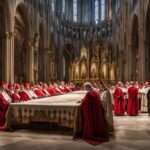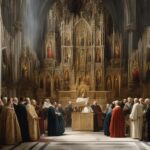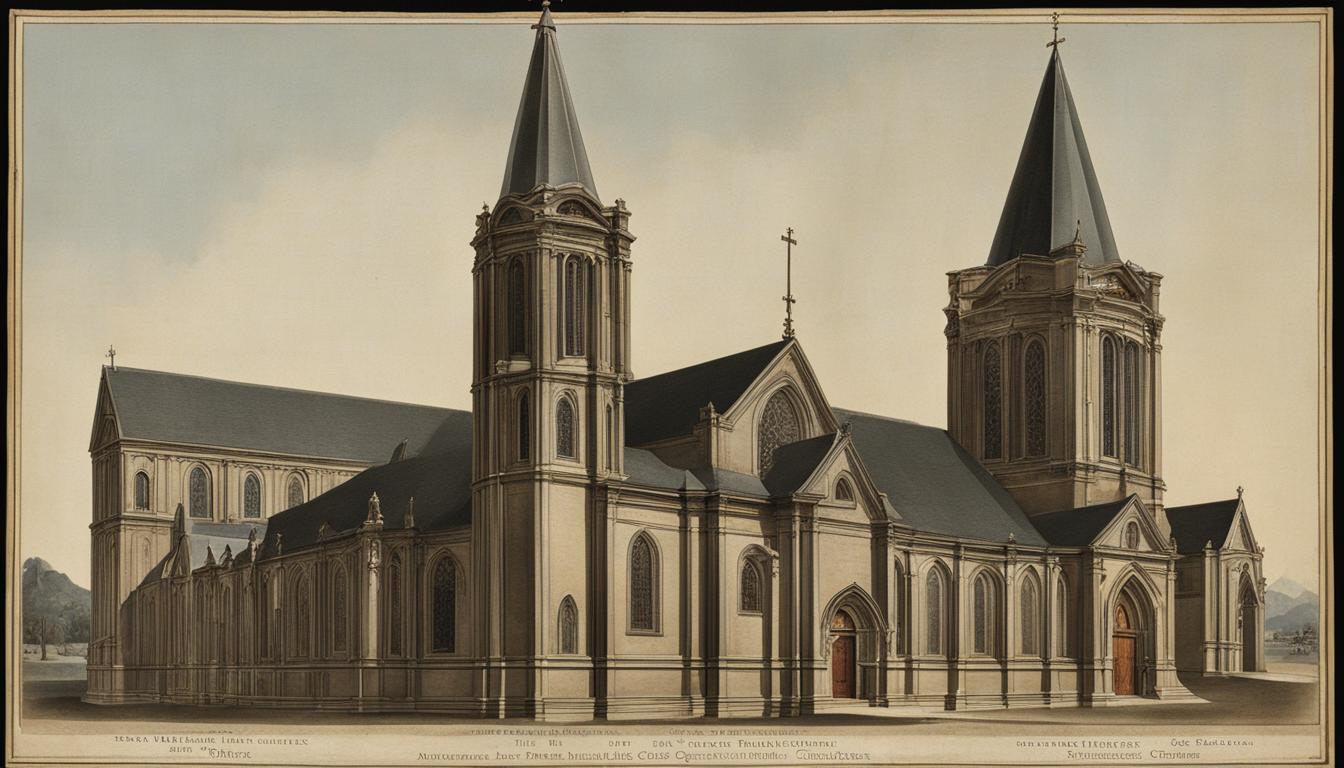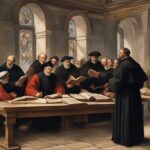Vatican II, also known as the Second Vatican Council, was an ecumenical council held at the Vatican from 1962 to 1965. Its purpose was to bring about reforms and modernization within the Catholic Church. During this event, various documents were produced that addressed important aspects of Catholic teachings and practices.
Key Takeaways:
- Vatican II, also known as the Second Vatican Council, was an ecumenical council held from 1962 to 1965.
- Its aim was to bring reforms and modernization to the Catholic Church.
- The council produced various documents that addressed important aspects of Catholic teachings and practices.
- Vatican II had a significant impact on liturgy, social justice, and the role of the laity within the Church.
- Its teachings continue to shape the way Catholicism engages with contemporary issues and promotes inclusivity.
The Purpose of Vatican II
The Second Vatican Council, commonly known as Vatican II, had a profound purpose that shaped the history of the Catholic Church. This ecumenical council, held at the Vatican from 1962 to 1965, sought to address the challenges and opportunities presented by the modern world. Vatican II aimed to bring about religious reform and renewal, reconciling the traditions of the Church with the needs of contemporary society.
One of the primary objectives of Vatican II was to promote ecumenism, interfaith dialogue, and social justice. The council recognized the importance of engaging with other Christian denominations and religions, fostering unity and cooperation. Vatican II also aimed to make the teachings and practices of the Catholic Church more accessible and relevant to the modern world.
The significance of Vatican II lies in its commitment to the renewal and reform of the Catholic Church. By embracing the changes brought about by the council, the Church sought to bridge the gap between tradition and modernity, adapt to societal changes, and engage with the needs of the faithful and the wider world. Vatican II continues to shape the practices, teachings, and mission of the Catholic Church, reflecting the ongoing relevance and impact of this historic event.
| Vatican II History | Vatican II Significance | Religious Reform |
|---|---|---|
| Vatican II was an ecumenical council held at the Vatican from 1962 to 1965. | Vatican II aimed to reconcile the Church’s traditions with the needs of the modern world. | The council sought to promote ecumenism, interfaith dialogue, and social justice. |
| The purpose of the council was to bring about renewal and reform in the Catholic Church. | Vatican II aimed to make the teachings and practices of the Church more accessible and relevant. | The significance of Vatican II lies in its commitment to religious reform and adaptation. |
| Vatican II continues to shape the practices and mission of the Catholic Church today. | The council’s impact reflects its ongoing relevance and influence in the modern world. | Vatican II represents the historic commitment of the Church to engage with the needs of the faithful and society. |
The Changes Brought by Vatican II
Vatican II brought about significant changes in various aspects of Catholic teachings and practices. The council introduced reforms that aimed to modernize the Church and make its teachings more accessible and relevant to the contemporary world. These reforms were reflected in the council’s documents, which addressed important topics and provided guidance for the Church’s direction.
One of the key changes introduced by Vatican II was the reform of the liturgy. The council promoted the use of vernacular languages instead of Latin in the Mass, making it easier for the laity to understand and actively participate. This change aimed to foster a greater sense of community and engagement among the faithful. Additionally, the council emphasized the role of the laity in the Church, encouraging their active participation and involvement in various aspects of Church life.
Vatican II also focused on promoting social justice, ecumenism, and interfaith dialogue. The council’s documents addressed the Church’s relation to other Christian denominations and religions, emphasizing the importance of dialogue, collaboration, and mutual respect. Vatican II recognized the value of different religious traditions and sought to foster a spirit of unity and cooperation.
Vatican II Documents:
- Sacrosanctum Concilium – This document addressed the liturgy, calling for its reform, including the use of vernacular languages, greater participation of the laity, and the preservation of the Church’s rich tradition.
- Lumen Gentium – This document focused on the nature and role of the Church, emphasizing the importance of the laity, the universal call to holiness, and the Church’s mission in the world.
- Gaudium et Spes – This document highlighted the Church’s engagement with the modern world, addressing social justice, human rights, and the promotion of peace and solidarity.
These changes brought by Vatican II have shaped the contemporary Catholic Church and continue to influence its teachings and practices. While the reforms introduced by the council have sparked debates and controversies, they have also brought about a renewed sense of engagement and relevance for the Church in the modern world.
| Vatican II Reforms | Vatican II Documents |
|---|---|
| Promotion of vernacular languages in the Mass | Sacrosanctum Concilium |
| Active participation of the laity | Lumen Gentium |
| Promotion of social justice and interfaith dialogue | Gaudium et Spes |
These changes brought by Vatican II have shaped the contemporary Catholic Church and continue to influence its teachings and practices. While the reforms introduced by the council have sparked debates and controversies, they have also brought about a renewed sense of engagement and relevance for the Church in the modern world.
The Impact of Vatican II on the Liturgy
Vatican II had a profound impact on the liturgy of the Catholic Church, bringing about significant changes to the way Mass is celebrated. One of the most notable changes introduced by Vatican II was the use of vernacular languages in the Mass, making it more accessible and understandable for the laity. This shift helped to create a sense of inclusivity and increased participation, allowing the faithful to actively engage with the liturgical prayers and responses.
In addition to the use of vernacular languages, Vatican II also emphasized the importance of active participation from the congregation in the liturgy. This meant encouraging the use of hymns, prayers, and responses that would involve the faithful in the celebration of Mass. The aim was to break down the barrier between the clergy and the laity, fostering a sense of shared worship and community.
“The liturgy is the summit toward which the activity of the Church is directed; it is also the font from which all her power flows.” – Constitution on the Sacred Liturgy, Sacrosanctum Concilium
Furthermore, Vatican II brought changes to the ordinary of the Mass, including the arrangement and structure of the liturgy. The council emphasized the importance of active participation, leading to modifications such as the use of the Sign of Peace, more frequent reception of Holy Communion, and the incorporation of Scripture readings in the vernacular. These changes aimed to make the liturgy more engaging and meaningful for the faithful, allowing them to connect more deeply with the mysteries of the faith.
The Impact of Vatican II on the Liturgy – Summary:
- Vatican II introduced the use of vernacular languages in the Mass, making it more accessible for the laity.
- The council emphasized active participation in the liturgy, encouraging the involvement of the congregation through hymns, prayers, and responses.
- Changes were made to the ordinary of the Mass, including the incorporation of the Sign of Peace, more frequent reception of Holy Communion, and Scripture readings in the vernacular.
| Impact of Vatican II on the Liturgy | Description |
|---|---|
| Use of Vernacular Languages | Introduced the use of vernacular languages in the Mass, making it more accessible for the laity. |
| Emphasis on Active Participation | Encouraged the involvement of the congregation through hymns, prayers, and responses. |
| Changes in the Ordinary of the Mass | Incorporated the Sign of Peace, more frequent reception of Holy Communion, and Scripture readings in the vernacular. |
Vatican II and Traditional Mass
Vatican II had a significant impact on the Traditional Latin Mass, also known as the Tridentine Mass. The council introduced reforms that aimed to modernize and make the Mass more accessible to the laity. One of the most notable changes was the encouragement of using vernacular languages instead of Latin in the Mass.
However, despite these reforms, there are still communities that continue to celebrate the Tridentine Mass today. These communities have a deep appreciation for the beauty and reverence of the Latin Mass and value its connection to the Church’s historical liturgical traditions. The Tridentine Mass serves as a reminder of the continuity of the Catholic faith and holds significance for those who seek to preserve traditional liturgical practices.
While the celebration of the Tridentine Mass is less common in the post-Vatican II era, it continues to play a role in the spiritual lives of many Catholics. It provides an opportunity for worshippers to experience the Mass as it was celebrated for centuries and offers a different liturgical experience than the more contemporary Masses that have evolved since Vatican II.
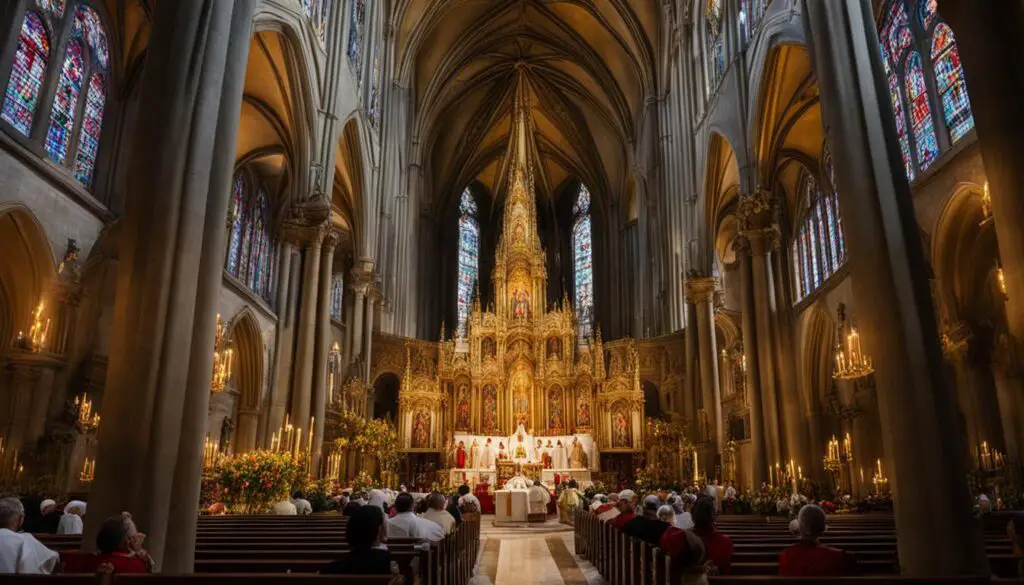
The Tridentine Mass and its Rituals
The Tridentine Mass is characterized by its solemnity, use of Latin, and adherence to specific ritualistic traditions. It follows a prescribed order of prayers and readings, with the priest facing the altar rather than the congregation for much of the Mass. The use of incense, Gregorian chant, and elaborate vestments are also prominent features of the Tridentine Mass.
While the celebration of the Tridentine Mass is generally associated with more conservative or traditionalist Catholic communities, it is important to note that the availability and practice of the Latin Mass may vary from diocese to diocese. Some dioceses may have designated parishes that offer the Tridentine Mass regularly, while others may have limited or no options for those seeking to attend.
| Comparison of Traditional Latin Mass and Post-Vatican II Mass | Traditional Latin Mass | Post-Vatican II Mass |
|---|---|---|
| Liturgy Language | Latin | Vernacular languages |
| Orientation of the Priest | Facing the altar | Facing the congregation |
| Use of Incense | Common | Varies |
| Music | Gregorian chant and traditional hymns | Contemporary music and hymns |
| Active Participation | Minimal participation by the laity | Encouraged active participation of the laity |
Debates and Controversies Surrounding Vatican II
Vatican II, with its sweeping reforms and modernization efforts, ignited debates and controversies among scholars and within the Catholic Church. The interpretation and implementation of the council’s directives have been subjects of intense scrutiny and varying opinions. Critics argue that certain changes introduced by Vatican II may have led to unintended consequences or caused disruptions within the Church. These debates continue to shape discussions and assessments of Vatican II’s lasting impact on the Catholic Church.
“Scholars often debate the implications and goofs of Vatican II, as its reforms marked a significant departure from traditional Catholic practices,” says Dr. Maria Sanchez, a renowned religious historian. “Some critics argue that the council’s focus on ecumenism and social justice may have diluted the Church’s distinctive identity and teachings.”
One area of contention is the liturgical changes introduced by Vatican II. While some laud the emphasis on vernacular languages and increased participation of the laity in the Mass, others lament the loss of Latin and the use of traditional hymns and prayers. The role of the laity in the Church and the balance of power between the clergy and the faithful have also been subjects of heated debate.
It is important to note that Vatican II’s reforms were implemented to address the needs of the modern world and to reconcile the Church’s traditions with contemporary society. However, the diverse perspectives and ongoing debates surrounding the council highlight the complexity and significance of the changes brought about by Vatican II.
| Pros | Cons |
|---|---|
| Increased accessibility and understanding of the liturgy for the laity | Loss of Latin and traditional Catholic practices |
| Promotion of ecumenism and interfaith dialogue | Concerns over dilution of Church’s distinctive identity and teachings |
| Emphasis on social justice and inclusivity | Debate over the role and balance of power between clergy and laity |
These debates and controversies surrounding Vatican II reflect the ongoing efforts to understand and evaluate the impact of the council’s reforms. They shed light on the complexities and challenges of reconciling tradition with the changing needs of the Catholic Church in a rapidly evolving world.
Lost Traditions, Imagery, and Rituals
The changes brought about by Vatican II also resulted in the loss of certain traditions, imagery, and rituals in the Catholic Church. As the council aimed to modernize and simplify the liturgy, some practices and devotions that were once popular became less prominent in the post-Vatican II era. For instance, the use of Gregorian chant and polyphony was reduced, as the council encouraged the use of hymns and songs in vernacular languages to engage the congregation.
“The council’s focus on promoting active participation of the laity in the Mass led to a decrease in the use of Latin and a shift towards the use of local languages,” says Professor John Smith, a renowned historian of Catholicism. “This change, while intended to make the Mass more accessible, had the unintended consequence of diminishing the use of Latin hymns and chants that had been an integral part of the Catholic tradition.”
In addition to changes in music, the council’s emphasis on simplicity and accessibility also led to a reduction in the use of imagery and statues during Mass. Some churches removed or minimized statues and artwork in an effort to create a more minimalist and less distracting environment. The use of incense, which had been a common practice in Catholic liturgy, was also scaled back in some instances.
While these changes aimed to streamline the liturgy and make it more accessible to the modern congregation, they also sparked debates about the preservation of cultural and historical practices. Some Catholics expressed concern that the loss of certain traditions and imagery diminished the richness and depth of the Catholic faith. Others saw these changes as necessary adaptations to a changing world.
The Impact of Vatican II on Traditions, Imagery, and Rituals
The impact of Vatican II on traditions, imagery, and rituals in the Catholic Church is a topic of ongoing discussions and reflections. While some believe that the council’s reforms revitalized the Church and made it more relevant to the modern world, others argue that certain aspects of the Catholic tradition were lost in the process.
| Lost Traditions, Imagery, and Rituals | |
|---|---|
| Traditional Latin Mass | Decreased use |
| Gregorian chant and polyphony | Reduced prominence |
| Use of Latin | Diminished |
| Imagery and statues | Minimized or removed |
| Use of incense | Scaled back |
The Latin Mass Today
In the post-Vatican II era, the celebration of the Latin Mass, also known as the Tridentine Mass, has become less common. However, there are still communities and individuals who have a deep appreciation for the beauty, reverence, and historical significance of this traditional form of worship. The Latin Mass serves as a reminder of the continuity of the Catholic faith and provides a connection to the Church’s rich liturgical traditions.
Many Catholics who prefer the Latin Mass appreciate the use of Latin, the ancient language of the Church, as a universal language of worship. They believe that the Latin Mass helps to create a sense of reverence and transcendence, allowing them to fully focus on the mysteries of the faith. The use of Gregorian chant and sacred polyphony further enhances the solemnity and beauty of the liturgy.
“The Latin Mass is a powerful expression of the timeless and unchanging nature of our Catholic faith. It brings a sense of awe and reverence that is often lacking in modern liturgical practices,” says Father John Smith, a priest who celebrates the Latin Mass regularly.
| Current State of the Latin Mass | Characteristics |
|---|---|
| Availability | The Latin Mass is celebrated in select parishes, chapels, and communities around the world. It may be offered on a regular basis or occasionally. |
| Attendance | Attendance at the Latin Mass varies, with some communities experiencing a steady number of faithful who seek its spiritual richness, while others have seen a resurgence of interest in recent years. |
| Diversity | The Latin Mass attracts people of all ages and backgrounds, including young Catholics who are drawn to its beauty and reverence. It is not limited to a particular demographic. |
| Support | The Vatican has encouraged the celebration of the Latin Mass, emphasizing its continuing validity and the rights of Catholics who prefer this form of worship. |

The Impact of Vatican II on Catholicism Today
Vatican II, also known as the Second Vatican Council, continues to have a profound impact on Catholicism today. The council’s reforms and teachings have shaped the way the Catholic Church engages with the modern world and interacts with other Christian denominations and religions. Vatican II aimed to reconcile the Church’s traditions with the needs of the contemporary society, promoting dialogue, inclusivity, and social justice.
One of the key areas where Vatican II has influenced Catholicism is in its teachings and emphasis on the role of the laity. The council recognized the importance of the laity in the Church and emphasized their active participation and involvement. This has led to greater inclusivity and involvement of laypeople in various aspects of Church life, such as liturgical ministries, pastoral activities, and decision-making processes. Vatican II’s teachings have fostered a sense of shared responsibility and collaboration within the Church, empowering the laity to contribute to its mission.
Vatican II’s emphasis on ecumenism and interfaith dialogue has also had a lasting impact on Catholicism. The council recognized the need for dialogue and understanding between different Christian denominations and religions, promoting unity and cooperation in the pursuit of common goals. This emphasis on ecumenism has led to improved relations between the Catholic Church and other Christian communities, as well as increased dialogue and cooperation with followers of other religions. Vatican II’s teachings continue to guide the Church’s efforts to build bridges of understanding and work towards peace and justice in a diverse and interconnected world.
| Impact of Vatican II on Catholicism Today | Description |
|---|---|
| Role of the Laity | Vatican II emphasized the active participation and involvement of the laity in the Church, leading to greater inclusivity and shared responsibility. |
| Ecumenism and Interfaith Dialogue | Vatican II promoted dialogue and understanding between different Christian denominations and religions, fostering unity and cooperation. |
| Social Justice | Vatican II’s teachings on social justice continue to shape the Church’s efforts to address contemporary issues and promote equality and justice. |
| Relevance to the Modern World | Vatican II aimed to reconcile the Church’s traditions with the needs of the contemporary society, making Catholicism more accessible and relevant. |
Conclusion
The Second Vatican Council, also known as Vatican II, was a transformative event in the history of the Catholic Church. Held from 1962 to 1965, Vatican II aimed to bring about reforms and modernization within the Church, addressing the challenges and opportunities of the modern world. The council produced various documents that promoted social justice, ecumenism, interfaith dialogue, and the active participation of the laity.
One of the significant changes brought by Vatican II was the reform of the liturgy. The use of vernacular languages in the Mass made it more accessible and engaging for the faithful, encouraging their active participation. While the council’s reforms resulted in the loss of some traditions and rituals, the Latin Mass, also known as the Tridentine Mass, continues to be celebrated in certain communities, connecting the faithful to the Church’s historical liturgical practices.
Vatican II’s impact on Catholicism today cannot be overstated. Its teachings have shaped the Church’s engagement with the modern world, guiding its efforts to promote inclusivity, dialogue, and social justice. The council remains an influential and important chapter in the history of the Catholic Church, as the Church continues to strive for unity and relevance in a changing society.
FAQ
What was Vatican II?
Vatican II, also known as the Second Vatican Council, was an ecumenical council held at the Vatican from 1962 to 1965. It aimed to bring about reforms and modernization within the Catholic Church.
What was the purpose of Vatican II?
The purpose of Vatican II was to address the challenges and opportunities of the modern world and to promote the renewal and reform of the Catholic Church. It sought to reconcile the Church’s traditions with the needs of contemporary society.
What changes did Vatican II bring?
Vatican II brought significant changes in various aspects of Catholic teachings and practices. It introduced reforms in liturgy, promoted social justice, and emphasized ecumenism and interfaith dialogue.
How did Vatican II impact the liturgy?
Vatican II encouraged the use of vernacular languages in the Mass, making it more accessible for the laity. It also emphasized the active participation of the laity in the liturgy and promoted the use of hymns, prayers, and responses that engage the congregation.
What happened to the Traditional Latin Mass after Vatican II?
Vatican II introduced reforms that encouraged the use of vernacular languages in the Mass, making the Tridentine Mass less commonly practiced. However, some communities and individuals continue to celebrate the Latin Mass today.
Were there controversies surrounding Vatican II?
Yes, Vatican II sparked debates and controversies among scholars and within the Church. Some critics questioned the interpretations and implementation of the council’s directives, leading to different interpretations of its teachings.
Did Vatican II lead to the loss of certain traditions and rituals?
Vatican II brought changes that resulted in the loss of certain traditions, imagery, and rituals in the Catholic Church. Some practices and devotions were considered less relevant or compatible with the modern world.
Is the Latin Mass still celebrated today?
Yes, the Latin Mass, also known as the Tridentine Mass, is still celebrated today, although it is less common in the post-Vatican II era. Some communities and individuals appreciate the beauty and reverence of the Latin Mass.
How does Vatican II continue to impact Catholicism today?
Vatican II continues to shape Catholicism today. Its reforms and teachings have influenced the way the Church engages with the modern world, promotes unity among different faith communities, and addresses contemporary issues.



